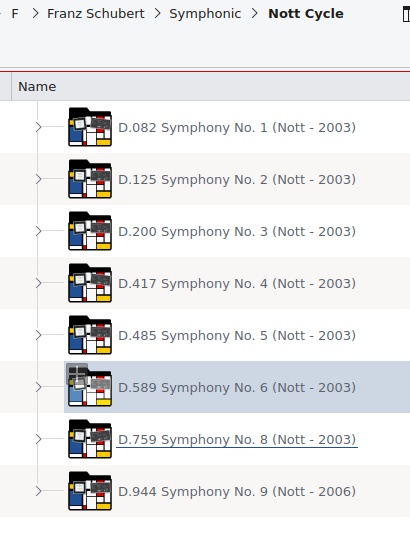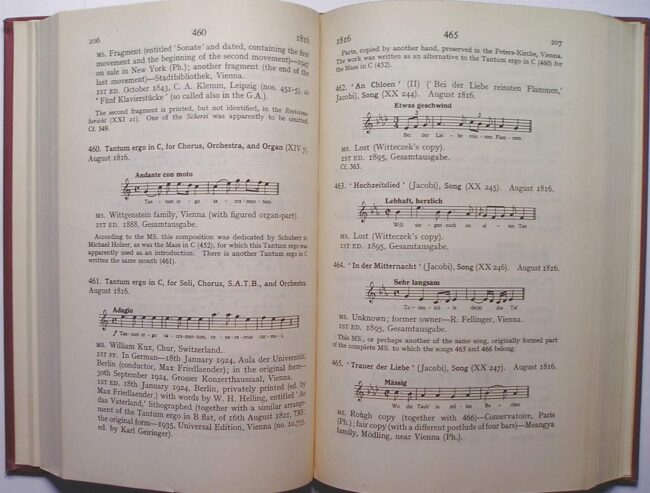 Schubert's symphonies are surprisingly tricky things to catalogue correctly, although as someone who hasn't exactly been been a huge a fan of the man or his works, it's taken me quite a long time to realise the extent of the problem!
Schubert's symphonies are surprisingly tricky things to catalogue correctly, although as someone who hasn't exactly been been a huge a fan of the man or his works, it's taken me quite a long time to realise the extent of the problem!
I noticed it today, though, as Giocoso decided to randomly select Schubert for a couple of plays:
Notice the Brüggen recording of Symphony No. 9 that took place at 11:31am and the Nott recording of Symphony No. 8 that finished at 7:50pm? Wonderful recordings both... but both are actually of the same symphony! So why is one labelled the 8th symphony and one the 9th? It's not me just being a dumb typist when tagging things up, that's for sure! Here's the Brüggen CD booklet:
 ...and here you see that the number 9 has been assigned to the symphony more formally catalogued as 'D.944' (the "D" stands for "Deutsch", the short-form name of Otto Erich Deutsch, who compiled the first catalogue of Schubert's works, published in 1951). Now here's the Nott booklet:
...and here you see that the number 9 has been assigned to the symphony more formally catalogued as 'D.944' (the "D" stands for "Deutsch", the short-form name of Otto Erich Deutsch, who compiled the first catalogue of Schubert's works, published in 1951). Now here's the Nott booklet:
Same Deutsch catalogue number - D.944 - but this time assigned to a symphony numbered number 8!
So what's going on?
Well, it's quite a complicated story, fully explained at Wikipedia if you'd prefer to get the details from there. The short version for my purposes is that there is no real disagreement about the numbering of symphonies 1 to 6. But thereafter it gets murky, with George Grove (he of the Dictionary of Music and Musicians fame) first numbering Schubert's symphonies in the 1860s as follows: D.729 = No. 7, D.759 = No. 8 and D.944 = No. 9. So, this first numbering is sort-of the one Brüggen is following, whereby the 'Great' No. 9 is Deutsch's later D.944.
Unfortunately, no lesser a man than Johannes Brahms supervised the first publishing of Schubert's works and decided he'd prefer the numbering as: D.729 = Not assigned a number at all; D.759 = No. 8 and D.944 = No. 7. Brahms being the man he was in the musical world, the Great symphony thus tended to get called the 7th symphony by most people for quite a long time. However, it's apparent that neither Brüggen nor Nott are following Brahms' numbering scheme.
George Grove again messed around with things in the early part of the twentieth century by re-numbering D.944 as Symphony No. 10, but fortunately no-one really took much notice.
Then, in 1978 the publishers of the Deutsch catalogue (Herr Deutsch himself having long-since passed on to the great metronome in the sky) decided to revise the catalogue... and the numbering became: D.729 = Not assigned a number at all, as per Brahms; D.759 = No. 7, unlike Brahms; and D.944 = No. 8, also not like Brahms!
But it hasn't stopped there, and subsequent discoveries and scholarship have moved things on once more, so that the most commonly-assigned numbers, at least in the English-speaking world, are generally considered now to be: D.729 = No. 7, D.759 = No. 8 (the 'Unfinished'), D.944 = No. 9 (the 'Great') and, a new one to add to the mix, D.936A = No. 10.
Honestly: this stuff makes the Koechel and Hoboken catalogues look positively sane! The same symphony has, at this point, now been assigned four different numbers: pick any one from 7 to 10!
So how does the simple classical music collector catalogue this stuff sanely, so that the same piece of music doesn't pop up in lists looking like completely different symphonies? Well, let's first rule out one commonly-adopted ploy: use of nicknames. Why not label the symphonies, whatever their CD booklet calls them, with their respective nicknames, such as 'Unfinished' or 'Great'? Well, leave aside the fact that this would tend to violate my Axiom 5 of the rules of classical tagging! The problem is simpler than that: two of the symphonies after the uncontested first six don't have nicknames at all. Also, 'U' gets sorted after 'G', so 'Unfinished' (symphony 8) would get sorted after 'Great' (symphony 9), potentially, depending on precisely where you stuck the nickname. You'd also still end up calling Nott's Symphony No. 8 'Great' and Brüggen's Symphony No. 9 'Great'... so nothing would really be resolved as far as the confusion factor is concerned!
So: my second suggestion would be to use the Deutsch numbers as a prefix to the symphony name: D.759 would get sorted before D.944, and thus symphonies 8 and 9 would be listed in the correct order. The trouble with that suggestion, however, is that the 'most commonly accepted numbering in the English-speaking world' is not the numbering that appears in the original or 1978 revised Deutsch catalogue. It is possible that that ordering might be present in the latest revision of the catalogue, of course, but I'm not paying €65 to find out!
A free online catalogue would be nice to access: the nearest I could find was the one at IMSLP, the free music score project. From that page, we have the numbering D.729 = No. 7, D.759 = No. 8 (Unfinished) and D.944 = No. 9 (Great), which is the 'generally accepted in the English-speaking world' numbering mentioned earlier, based on Deutsch 1978, but clearly picking up the later scholarship. It even lists D.936A as Symphony No. 10. So: since it's freely available online, whether it completely comports with the latest Deutsch catalogue or not, it's the numbering/naming system I'm running with.
A couple of issues remain to be resolved. First: Wikipedia mentions "D 944", whereas IMSLP lists "D.944": do you put a space or a period/full-stop between the D and the first digit? Or maybe you just run the things together and live with 'D944'? Plenty of CDs seem to do this, after all. Well, the catalogue itself is not of much use on this point, since it merely lists numbers:
The Neue Schubert Ausgabe ('New Schubert Edition'), busy publishing scholarly versions of all Schubert's works, has adopted the space convention: thus, they refer to the opera fragment Die Spiegelritter as "D 11" and they might be considered to be authoritative on the subject? Some editors of the Wikipedia pages concerning Schubert's piano compositions do take this approach as more-or-less gospel: I think D should not have a period after it, as that's the style used by the Neue Schubert-Ausgabe ... I agree that "D" should be without period. That seems to be the dominant usage ...and so on. Well: in the end, it doesn't really matter that much... so long, as always, you are consistent about it. From a purely computing theory point of view, I dislike spaces ('nothing') being treated as if they are of significance, however; it's also waaay too easy to type multiple spaces without noticing -and extra spaces will totally screw up an ordered list produced by a computer. So: I'm adopting the period/full-stop nomenclature.
Lastly: how many Deutsch numbers are there, because numbering systems on computers need to be of consistent length if they are to sort correctly? If Symphony No. 1 is D.82 and Symphony No. 7 is D.729, then catalogued in that way, Symphony 7 is going to list before Symphony 1, since the '7' of 729 is going to be compared to the '8' of '82':
Perusing the IMSLP catalogue, we see that the biggest assigned Deutsch number is D.998 (though a pile of text addenda are appended to the catalogue after that, which is annoying from the cataloguing-and-correctly-ordering point of view!) -so this means that all Deutsch numbers should be three digits long.
Based on all these considerations, therefore, I will henceforth be re-cataloguing all my Schubert symphonies as follows:
- D.082 Symphony No. 1
- D.125 Symphony No. 2
- D.200 Symphony No. 3
- D.417 Symphony No. 4
- D.485 Symphony No. 5
- D.589 Symphony No. 6
- D.729 Symphony No. 7
- D.759 Symphony No. 8
- D.944 Symphony No. 9
- D.936a Symphony No. 10
...with the results looking something like this for the specific recordings conducted by Jonathan Nott:
 This means that my 'symphony no...' bit no longer agrees with the material contained within the CD booklet accompanying these recordings, which is annoying; but it will mean that the same 'symphony no...' bit of text will appear next to the same Deutsch number in a consistent manner, no matter who was conducting the various recordings I have of these symphonies, and no matter in what period the recordings were made (recordings made before 1978, for example, are inevitably going to use the 'wrong' symphony numbers).
This means that my 'symphony no...' bit no longer agrees with the material contained within the CD booklet accompanying these recordings, which is annoying; but it will mean that the same 'symphony no...' bit of text will appear next to the same Deutsch number in a consistent manner, no matter who was conducting the various recordings I have of these symphonies, and no matter in what period the recordings were made (recordings made before 1978, for example, are inevitably going to use the 'wrong' symphony numbers).
It's rather a lot of re-cataloguing, I'm afraid, as I have six complete symphony cycles, plus a handful of one-off 'miscellaneous' ones -and I will also need to go back to the Giocoso database and make amendments there, too. However, even having just started on this re-cataloguing journey, my website's list of today's music plays already at least has Nott and Brüggen playing the same numbered symphony:
Now I just need to add the Deutsch numbers to all my non-Nott recordings!
The moral of this particular story, therefore, is: get your Schubert cataloguing right from the outset, not after multiple decades of collecting his stuff and adding it to your library by merely following the text provided in the accompanying CD booklet, which will likely be wrong for any recordings made before about 1980!




